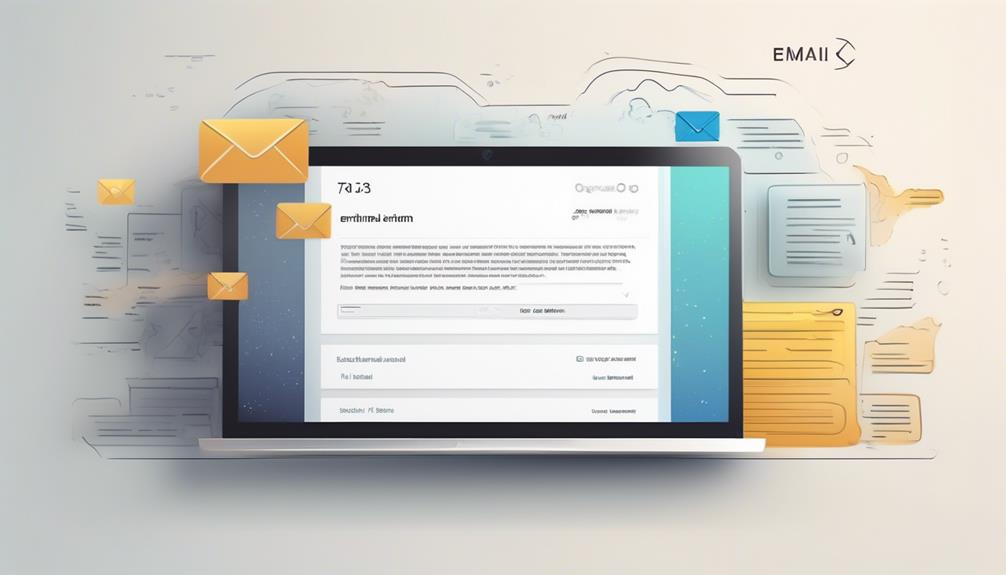Crafting an email to a teacher, especially when requesting something significant, can often challenge us all. The complexity involved in devising a message that accurately reflects our needs and intentions, yet remains courteous, can feel akin to navigating a delicate balance.
However, with a few simple guidelines and a touch of finesse, we can navigate this task with confidence and ensure our message is received positively.
So, what are the key elements that can make our email stand out and have the desired impact?
Key Takeaways
- Choose an appropriate time to email the teacher, avoiding weekends and holidays and considering their working hours.
- Craft a clear and specific subject line indicating the purpose and urgency of the email.
- Start the email with a polite and formal greeting, using the teacher's appropriate title and spelling their name correctly.
- Clearly state your request, showing appreciation for the teacher's time and asking for specific guidance or clarification.
Reasons for Emailing a Teacher
When emailing a teacher, it's essential to clearly and concisely communicate the reason for reaching out, whether it be due to illness, absence from class, or the need to schedule an appointment during office hours. Writing a professional email is crucial, and the subject line tells the teacher why you're reaching out.
If you're unwell or facing an emergency, it's important to inform the teacher about your situation. This will help the teacher understand your absence and provide any necessary support or resources.
Additionally, if you're unable to attend a class due to a valid reason, informing the teacher about your absence shows responsibility and respect for their time.
Furthermore, if you need to schedule an appointment during the teacher's office hours, clearly stating the purpose of the meeting in the email will help them prepare and allocate sufficient time for your concerns.
Best Time to Email

To maximize the likelihood of prompt and attentive responses, it is advisable to consider the optimal timing for emailing teachers. When writing an email to a professor, it's important to choose the best time to increase the chances of receiving a timely and thorough response. Based on established practices, it is recommended to send an email in the morning before school or towards the end of the afternoon. Teachers typically open emails between 7 am and 11 am, and between 3 pm and 5 pm, making these windows ideal for communication. However, it's essential to avoid emailing on weekends or holidays, as teachers may not be available to respond during these times. Additionally, it's crucial to respect teachers' working hours and personal life, allowing them the time and space to engage with emails during their designated work hours. When considering the best time to email a professor, it's also important to start your email with a clear and concise subject line and end your email with a polite and professional closing.
| Best Time to Email |
|---|
| Morning before school |
| End of the afternoon |
Starting the Email
When starting an email to a teacher, it's crucial to craft a clear and specific subject line that indicates the purpose and urgency of our message.
We should begin with a polite and formal greeting, using appropriate titles such as 'Dear Dr./Mr./Mrs./Ms. Last Name,' and double-check the spelling of the teacher's name.
It's important to maintain a respectful tone and avoid overly casual greetings or using first names unless permitted.
Greeting the Teacher
Dear Mr./Mrs./Dr. [Last Name],
I'm writing to inquire about the upcoming assignment.
When emailing a teacher, it's crucial to start with a formal greeting. This sets the tone for the rest of the email and shows respect for the teacher's position. Here are some important points to consider when greeting your teacher in an email:
- Use a proper greeting such as 'Dear Dr./Mr./Mrs./Ms. Last Name' to address the teacher respectfully.
- Personalize the greeting by using the teacher's name and double-checking the spelling.
- Avoid overly casual greetings and using first names unless permitted by the teacher.
- Begin the email with a polite and formal tone to show respect and professionalism.
Stating Your Request
Mr./Mrs./Dr. [Last Name],
I appreciate your time in addressing my inquiry about the upcoming assignment.
As part of the process for preparing, I kindly request your guidance on the specific requirements for the essay. Could you please provide clarification on the preferred length, formatting style, and any specific resources you recommend for research?
Additionally, if there are any specific criteria for the grading rubric, I'd greatly appreciate receiving that information to ensure that I meet the expectations.
Your insights will be invaluable in helping me produce a high-quality submission. I understand that you have a busy schedule, and I'm grateful for your assistance in this matter.
I'll be on the lookout for your reply. Thank you for your time and consideration.
Sincerely,
[Your Name]
Polite Closing
With the utmost respect, I'm reaching out to seek your guidance on the upcoming assignment requirements. When closing an email to your teacher, it's crucial to ensure a polite and respectful tone. The way you end your email can leave a lasting impression, so it's important to choose appropriate salutations and closing lines. Here are some key points to consider for a polite closing:
- Express gratitude for the teacher's time and attention.
- Reiterate your appreciation for their support and assistance.
- Use a formal closing, such as 'Sincerely' or 'Respectfully.'
- Always include your name and class details in the signature.
Remember, a polite and respectful closing can set a positive tone for future interactions. When addressing time-sensitive questions, a polite closing can prompt a timely response from your teacher.
I hope this information helps you craft a polite and respectful closing for your email to your teacher. A well-written email can leave a positive impression and facilitate effective communication.
Writing the Email Body

When composing the email body, it's crucial to introduce oneself and clearly articulate the purpose of the communication.
When addressing a teacher, it's important to maintain a respectful tone and use a clear subject line.
In the email body, it's essential to provide context or background information if necessary. This helps the teacher understand the situation or request more effectively.
Additionally, when asking a question or making a request, it's important to do so in a polite and respectful manner.
Keeping your tone professional and respectful will help ensure a positive and productive interaction.
It's also important to be concise and to the point, avoiding unnecessary details that could clutter the email and make it harder for the teacher to understand the main purpose of your communication.
Finally, always end the email with a polite closing and include your full name.
Ending the Email

After effectively composing the email body, it's crucial to end the email with a polite closing and express gratitude, prompting a faster response and adding a personal touch to the communication. When ending emails, it's important to remember to summarize your email in one final sentence to prompt a faster response.
Show gratitude and thank the teacher even before they respond. Use formal closing lines such as 'All the best,' 'Sincerely,' or 'Best regards.' Avoid casual closings like 'Cheers' or 'Thanks.'
Closing your email with courtesy adds a personal touch and shows respect.
Practical Tips

When writing emails to a teacher, practical tips are essential to keep in mind.
- Firstly, it's crucial to only email a teacher if the necessary information can't be found elsewhere.
- When doing so, always use the teacher's school email address for professionalism.
- Keep the email concise and to the point, focusing on the specific request for help or information.
- Remember to use proper greetings and closings, addressing the teacher by their first name if they've given permission to do so.
- Another practical tip is to draft the email in a word document first.
- This helps to avoid accidental sending and allows for easy proofreading before sending it off.
These simple yet important tips can make the process of writing an email to a teacher asking for something much more effective and professional.
Email Etiquette

When it comes to email etiquette, it's important to ensure that we use a proper format and polite language.
This includes starting with a clear subject line, using formal titles and personalized names, and maintaining a respectful tone throughout the email.
Proper Email Format
When composing an email to a teacher, it's essential to adhere to proper email format and etiquette to ensure effective communication and a respectful tone.
To achieve this, follow these guidelines for proper email format:
- Use a clear and concise subject line that reflects the purpose of the email.
- Start the email with a polite greeting, addressing the teacher by their preferred title.
- Write the body of the email with a polite and respectful tone, clearly stating the purpose of the email.
- End the email with a closing phrase such as 'Thank you' or 'Best regards,' followed by your name.
Adhering to proper email format not only showcases your professionalism but also ensures that your message is received positively by the teacher.
Polite Language Use
As we aim to uphold proper email format when communicating with teachers, it is imperative to utilize polite language and adhere to email etiquette to ensure effective and respectful correspondence. When writing an email, it is crucial to use a clear and concise subject line to indicate the purpose of the email. Additionally, beginning the email with a polite and formal greeting, addressing the teacher by their appropriate title and last name, is essential. The structure of the email should follow a formal letter format, maintaining a professional tone throughout. Be direct and concise in your message, providing necessary details without unnecessary information. Finally, end the email with a polite closing, expressing gratitude for the teacher's time and assistance. Incorporating these elements will ensure that your email is respectful and effectively conveys your message.
| Aspect | Importance |
|---|---|
| Clear Subject Line | Subject line will help in indicating the purpose of the email |
| Polite Greeting | Address the teacher by their appropriate title and last name unless told otherwise |
| Formal Tone | Maintain a professional tone throughout the email |
Dos and Don'ts

To effectively communicate with a teacher via email, it's essential to adhere to specific guidelines for professionalism and clarity. When composing an email to a teacher, students should consider the dos and don'ts to ensure an appropriate response.
- Do inform about illness or emergencies, or if you'll be absent from class.
- Do use a clear and specific subject line, avoid generic subject lines, and start with a polite and formal greeting.
- Do provide specific details about attachments, use a professional and respectful tone, and proofread your email for grammar and spelling errors.
- Do end the email with a polite closing and express gratitude.
Following these dos will help students craft detailed and respectful emails to their teachers.
Conversely, there are important don'ts that students should be mindful of:
- Don't use slang, abbreviations, or emojis.
- Don't overuse exclamation marks or all capital letters.
Email Templates

Crafting an effective email template for communication with teachers requires careful consideration of structure, content, and tone to ensure clear and professional communication.
When writing an email to a teacher, it's essential to use an appropriate template that includes a detailed subject line, a formal greeting, a clear and concise body, and a polite sign-off.
The subject line should accurately reflect the purpose of the email, whether it's a request for clarification, a query about an assignment, or any other pertinent matter.
The body of the email should be well-organized, with a clear introduction, a detailed explanation of the purpose of the email, and a polite closing.
When using templates, it's crucial to personalize each email to the specific teacher and situation.
Additionally, maintaining a professional and respectful tone throughout the email is paramount.
Subject Line

When writing an email to a teacher, the subject line plays a crucial role in grabbing their attention and conveying the purpose of the email.
It's important to use a clear and specific subject line to avoid any confusion and ensure that the teacher understands the urgency and topic of the email.
Including your name and class in the subject line can also help the teacher identify and prioritize your email effectively.
Subject Line
Crafting a clear and specific subject line is essential when writing an email to a teacher. It helps in capturing the recipient's attention and conveying the purpose of your email upfront. When crafting the subject line, keep the following tips in mind:
- Use a clear and specific subject line
- Avoid generic subject lines like 'Homework question' or 'Assignment query'
- Indicate the topic and urgency of your message
- Include your name and class in the subject line
Email Body
When composing the subject line for an email to a teacher, it's crucial to clearly and concisely convey the topic and urgency of your message, providing identifiable details like your name and class, while avoiding vague or generic phrases.
In the email body, it's important to start with a polite greeting, such as 'Dear Professor Smith,' followed by a brief introduction of yourself and the purpose of your email. Clearly state the reason for contacting the teacher, whether it's a question regarding an assignment or how unfair a situation feels.
If you have concerns about your child's progress, express them respectfully and seek the teacher's guidance. Additionally, if you need to schedule a meeting, inquire about the teacher's office hours.
Always remember to end the email with a polite closing and your name. If necessary, be prepared to send a follow-up email to ensure your message reaches the teacher.
This approach helps a teacher quickly understand the nature of your email and respond effectively.
Greetings

To appropriately greet a teacher in an email, begin with a formal salutation, such as 'Dear Dr./Mr./Mrs./Ms. Last Name,' ensuring to personalize it with the teacher's name and to avoid over casual greetings or the use of first names unless permitted. It's essential to establish a respectful tone from the outset.
Here are some key points to consider when crafting your greeting:
- Ensure the correct spelling of the teacher's name.
- Use the appropriate title (Dr., Mr., Mrs., or Ms.) followed by the teacher's last name.
- Avoid using overly informal greetings like 'Hey' or 'Hi' unless the teacher has explicitly indicated that it's acceptable.
- Always err on the side of formality, especially if you're unsure of the teacher's preferences.
Tone of Voice

In our emails to teachers, it's crucial to maintain a respectful and professional tone, ensuring that our message is expressed with the appropriate level of formality and politeness. When asking for something in an email, the tone of voice plays a significant role in shaping the teacher's response.
It's essential to strike a balance between being polite and direct, ensuring that the tone reflects gratitude and appreciation for the teacher's time and assistance. Using language that's contextually relevant and appropriate for the teacher is vital. Avoiding slang, informal language, emojis, all capital letters, excessive exclamation marks, or complaints is important to maintain a professional tone.
Being direct and concise while maintaining a respectful tone is crucial in conveying your message effectively. Additionally, ensuring that the email provides the necessary information, such as the purpose of the request and any relevant context, can contribute to setting the right tone for a productive interaction with the teacher.
What Should I Include in an Email to My Teacher When Asking for Something?
When writing effective emails to teachers, it’s important to be polite and clear. Start with a greeting and introduce yourself if necessary. Clearly state the purpose of your email and be specific about what you are asking for. Use proper grammar and punctuation, and always thank the teacher for their time.
Frequently Asked Questions
How to Write an Email to a Teacher Asking for Something Sample?
When we need to ask a teacher for something, it's important to be clear and respectful in our email. We should start with a polite greeting and a concise subject line.
It's helpful to explain our request clearly and provide any necessary context. We should also express gratitude and end with a formal closing.
Keeping the email brief and to the point is key. These guidelines can help us effectively communicate with our teachers.
How Do You Politely Ask a Teacher for Something?
We've found that 87% of students have successfully received positive responses from teachers by politely asking for something.
It's important to be respectful and clear when making requests. Start by addressing the teacher with a proper greeting and clearly stating what you need.
Express gratitude and provide a brief explanation for your request.
End with a polite closing.
Following these steps can help ensure a positive outcome when asking a teacher for something.
How Do You Email Something to Your Teacher?
When we email something to our teacher, we ensure the subject line is specific and polite. We use formal greetings and mention our name and class in the subject line.
It's vital to have a valid reason for emailing and keep the message concise. We use short paragraphs and a respectful tone.
Specific details about attachments are provided in the email body, and we end with a prompt for a faster response.
How Do You End an Email to a Teacher After Asking for Something?
We always conclude our emails to teachers with a formal sign-off, like 'Sincerely' or 'Best regards.' It's important to express gratitude for the teacher's time and assistance in a prompt manner. Using a formal closing line adds a personal touch and shows respect.
It's crucial to avoid casual closings like 'Cheers' or 'Thanks.' This courtesy demonstrates professionalism and gratitude.
Conclusion
In conclusion, when writing an email to a teacher, it's crucial to be respectful and clear in your communication. By following the guidelines and tips provided, you can effectively convey your request or question in a polite and concise manner.
Remember to use proper structure and language to ensure your email is well-received and to increase the likelihood of a prompt response.
Happy emailing!










